
Stachys is a genus of plants, one of the largest in the mint family Lamiaceae. Estimates of the number of species vary from about 300, to about 450. Stachys is in the subfamily Lamioideae and its type species is Stachys sylvatica. The precise extent of the genus and its relationship to other genera in the subfamily are poorly known.

Taxodium mucronatum, commonly known as Montezuma bald cypress, Montezuma cypress, or ahuehuete, is a species of Taxodium that is primarily native to Mexico and Guatemala, with a few populations in the southwestern United States. Ahuehuete is derived from the Nahuatl name for the tree, āhuēhuētl, which means "upright drum in water" or "old man of the water."

Bouteloua curtipendula, commonly known as sideoats grama, is a perennial, short prairie grass that is native throughout the temperate and tropical Western Hemisphere, from Canada south to Argentina.

Quercus coccinea, the scarlet oak, is a deciduous tree in the red oak section Lobatae of the genus Quercus, in the family Fagaceae.
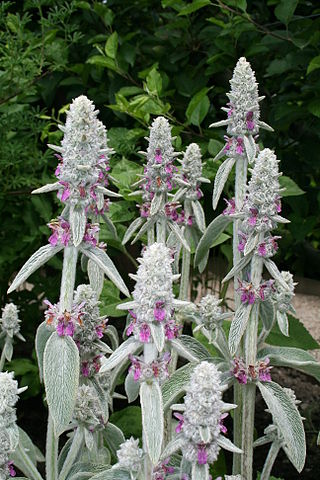
Stachys byzantina, the lamb's-ear or woolly hedgenettle, is a species of flowering plant in the mint family Lamiaceae, native to Armenia, Iran, and Turkey. It is cultivated throughout much of the temperate world as an ornamental plant, and is naturalised in some locations as an escapee from gardens. Plants are very often found under the synonym Stachys lanata or Stachys olympica.
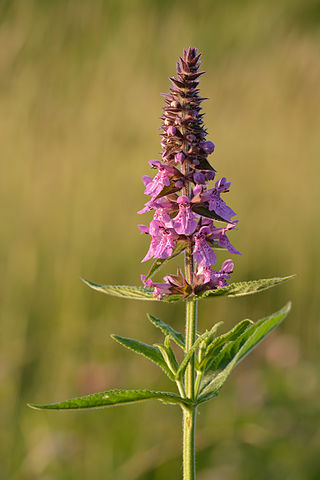
Stachys palustris, commonly known as marsh woundwort, marsh betony, clown's woundwort, clown's heal-all, marsh hedgenettle, or hedge-nettle, is an edible perennial grassland herb growing to 80 centimeters tall. It is native to parts of Eurasia but has been introduced to North America. The species epithet palustris is Latin for "of the marsh" and indicates its common habitat.
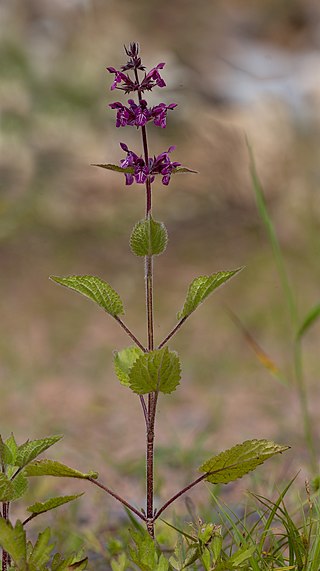
Stachys sylvatica, commonly known as hedge woundwort, whitespot, or sometimes as hedge nettle, is a perennial herbaceous plant growing to 80 cm (31 in) tall in woodland and unmanaged grassland. In temperate zones of the northern hemisphere it flowers in July and August. The flowers are purple. The leaves, when crushed or bruised, give off an unpleasant fetid smell.
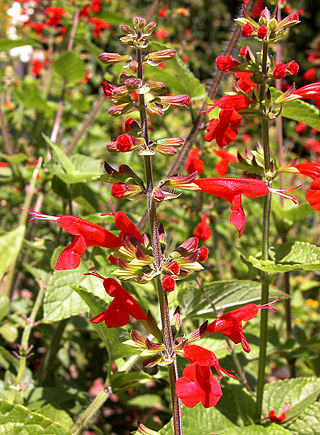
Salvia coccinea, the blood sage, scarlet sage, Texas sage, or tropical sage, is a herbaceous perennial in the family Lamiaceae that is widespread throughout the Southeastern United States, Mexico, Central America, the Caribbean, and northern South America. At one time Brazil was considered to be where it originated, but its diploid chromosome count now points to Mexico as its place of origin.
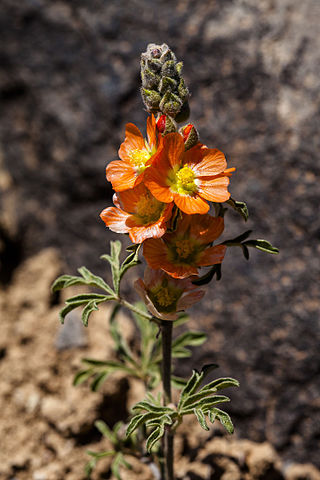
Sphaeralcea coccinea, commonly known as the scarlet globemallow, scarlet mallow, cowboy's delight, prairie mallow, red false mallow, or simply as globe mallow is a perennial plant growing 10–30 cm tall from spreading rhizomes with a low habit. They have grayish stems with dense, star-shaped hairs and alternately arranged leaves. The leaf blades are 2–5 cm long, palmately shaped, and deeply cut, with 3–5 main wedge-shaped segments. The undersides of the leaves have gray hairs. The 1–2.5 cm wide flowers are reddish-orange and saucer-shaped, with 5 notched, broad petals, in small terminal clusters. It produces numerous stamen which surround the pistils as a tube. Plants flower from May to October in southern regions and May to July in northern regions. The plant produces a dry "fruit" called a schizocarp, which after maturity, breaks into roughly 10 or more seed segments.
× Heucherella is an evergreen perennial flowering plant in the family Saxifragaceae. A hybrid of garden origin, it is the result of a cross between two distinct genera, Heuchera and Tiarella, and shows similarities to both parents. This type of intergeneric hybrid is quite rare, and is indicated by a multiplication symbol before the name. The name Heucherella is an example of a portmanteau word, a combination of the two parents' names.

Stachys arvensis is a species of flowering plant in the mint family known by the common names field woundwort and staggerweed. It is native to Europe, Western Asia, and North Africa. It is known on other continents as an introduced species and widespread weed.

Prunus caroliniana, known as the Carolina laurelcherry, Carolina cherry laurel, Carolina cherry, or Cherry laurel, is a small evergreen flowering tree native to the lowlands of Southeastern United States, from North Carolina south to Florida and westward to central Texas. The species also has escaped into the wild in a few places in California.
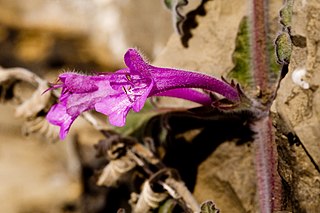
Salvia summa, the great sage or supreme sage, is a herbaceous perennial plant that is native to a small area in southern New Mexico, an adjacent area in northern Texas, and in Chihuahua, Mexico. The plant grows on limestone cliffs in part shade at 1,520 to 2,140 m elevation.

Yucca aloifolia is the type species for the genus Yucca. Common names include aloe yucca, dagger plant, and Spanish bayonet. It grows in sandy soils, especially on sand dunes along the coast.
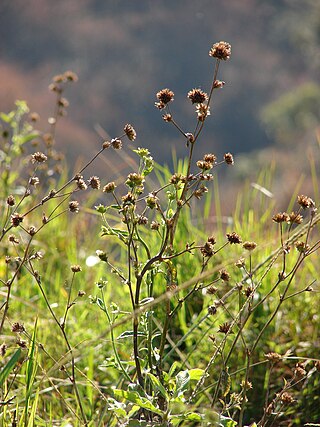
Elephantopus mollis, common names tobacco weed, and soft elephantsfoot, is a tropical species of flowering plant in the family Asteraceae.
Tagetes foetidissima is a Mesoamerican species of marigolds in the family Asteraceae. It is widespread across much of Mexico and Central America from Tamaulipas to Costa Rica. Common name is "flor de muerto," Spanish for "death flower."
Gaillardia coahuilensis, the bandanna daisy, is a North American species of flowering plant in the sunflower family. It is native to northwestern Mexico (Coahuila) and the southwestern United States.
Gaillardia multiceps, the onion blanketflower, is a North American species of flowering plant in the sunflower family. It is native to the southwestern United States.

Hymenothrix wislizeni, the Trans-Pecos thimblehead, is a North American species of flowering plant in the daisy family. It grows in northwestern Mexico and the southwestern United States.

Diplacus puniceus, commonly known as the red bush monkeyflower, San Diego monkey flower, or mission diplacus, is a species of perennial shrub native to coastal southern California and northern Baja California. It is characterized by a relatively small and broad corolla for Diplacus, a lack of glandular hairs, and dark orange or red flowers, adapted to hummingbird pollinators.
















